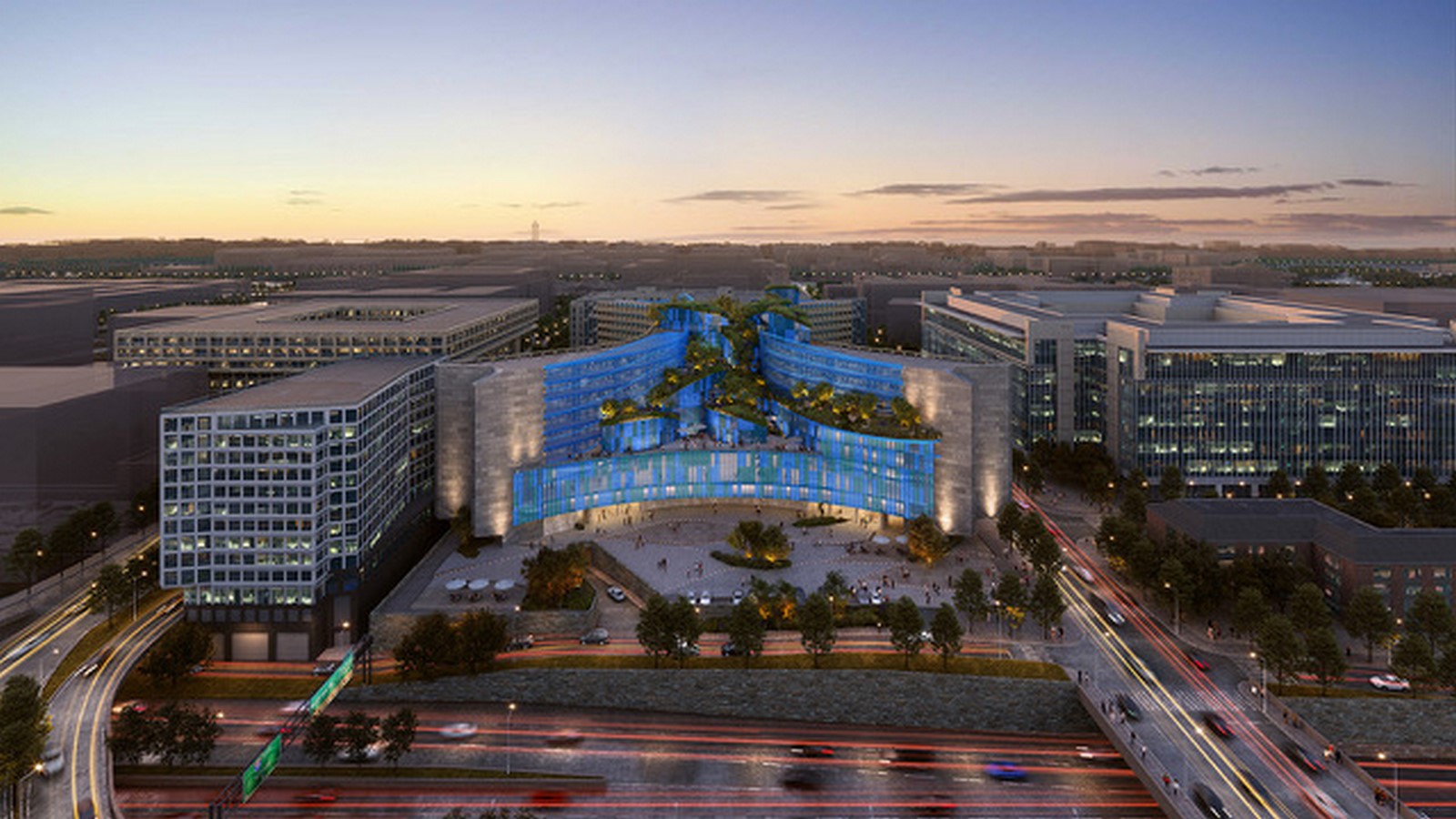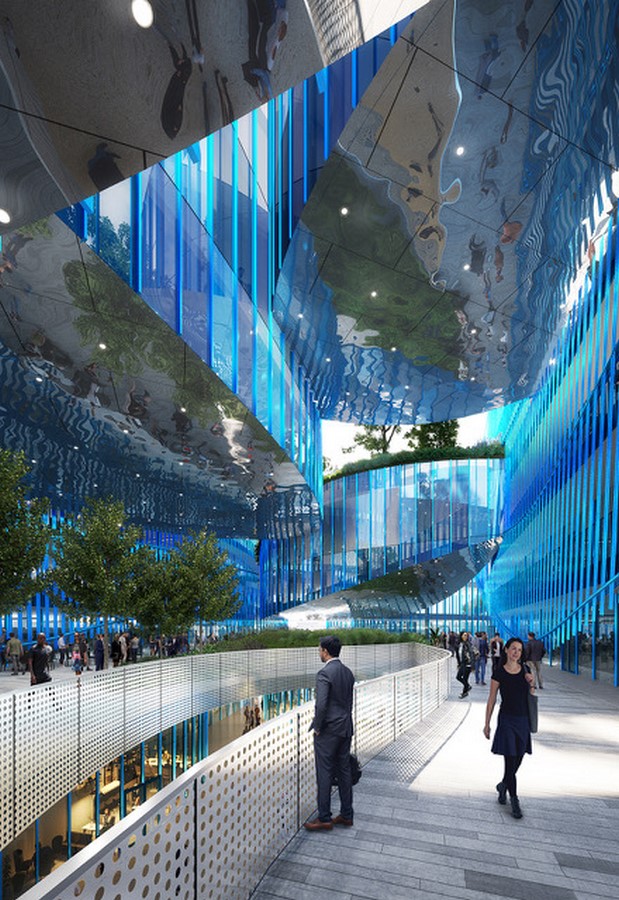Like many American cities, Downtown Washington, DC is facing a familiar crisis due to the surge in remote work. Across the country, downtown areas have been left vacant as workers, residents, and visitors have shifted away. This exodus has put immense pressure on commercial real estate, with major office tenants downsizing or abandoning their leases. More than half of American workers—some 70 million people— can perform their jobs remotely, according to a June 2022 Gallup analysis, and a mere 6 percent of them ever want to return to working full-time in an office; most say they would look for a different job if their employer forced the issue. Gallup forecasts that more than half of those remote-capable employees will work a hybrid schedule going forward, and 22 percent will work entirely offsite in the years to come.
Project Name: Marcel Breuer’s Brutalist Washington DC Offices
Studio Name: BROOKS + SCARPA

However, the situation in DC differs from that of other US cities. A unique factor is that a significant portion of downtown office space is under the control of a single landlord: the federal government. Despite the government’s implementation of various telework policies, all 24 federal agencies have reported that their in-person workforce has not returned to pre- pandemic levels due to remote work. This shift has had a profound impact on the heart of DC.
Arecentreportfromthe USGovernment Accountability Office highlights the severity of the issue. During three weeks in January, February, and March, 17 of the 24 federal agency headquarters, primarily located in DC, utilized only about 25% of their building capacity on average. Utilization rates across these headquarters ranged from approximately 10% to 50%.
SOARING VACANCIES IN FEDERAL OFFICE BUILDINGS
Example of public housing in Washington DC constructed during the height of power of HUD
The Robert C. Weaver Federal Building is a 10-story 700,000 square foot office building in Washington, D.C., owned by the federal government of the United States. Completed in 1968, it serves as the headquarters of the United States Department of Housing and Urban Development. A recent report from the US Government Accountability Office highlights the severity of vacancies in federal office buildings in Washington, DC. During three weeks in January, February, and March, 17 of the 24 federal agency headquarters, primarily located in DC, utilized only about 25% of their building capacity on average. Utilization rates across these headquarters ranged from approximately 10% to 50%.
The problem of unused space in federal office buildings has been a long-standing concern, but it has escalated significantly since almost half of the country’s two million federal employees transitioned to remote work during the public health emergency. This intensification exacerbates the challenges faced by downtown DC and emphasizes the need for innovative solutions to revitalize the urban core.
Above: View of HUD building from adjacent residential neighborhood
The Robert C. Weaver Federal Building is a 10-story 700,000 square foot office building in Washington, D.C., owned by the federal government of the United States. Completed in 1968, it serves as the headquarters of the United States Department of Housing and Urban Development.
Like many American cities, Downtown Washington, DC is facing a familiar crisis due to the surge in remote work. Across the country, downtown areas have been left vacant as workers, residents, and visitors have shifted away. This exodus has put immense pressure on commercial real estate, with major office tenants downsizing or abandoning their leases. More than half of American workers— some 70 million people—can perform their jobs remotely, according to a June 2022 Gallup analysis, and a mere 6 percent of them ever want to return to working full-time in an office; most say they would look for a different job if their
employer forced the issue. Gallup forecasts that more than half of those remote- capable employees will work a hybrid schedule going forward, and 22 percent will work entirely offsite in the years to come.

However, the situation in DC differs from that of other US cities. A unique factor is that a significant portion of downtown office space is under the control of a single landlord: the federal government. Despite the government’s implementation of various telework policies, all 24 federal agencies have reported that their in-person workforce has not returned to pre-pandemic levels due to remote work. This shift has had a profound impact on the heart of DC.
A recent report from the US Government Accountability Office highlights the severity of the issue. During three weeks in January, February, and March, 17 of the 24 federal agency headquarters, primarily located in DC, utilized only about 25% of their building capacity on average. Utilization rates across these headquarters ranged from approximately 10% to 50%.
The problem of unused space in federal office buildings has been a long- standing concern, but it has escalated significantly since almost half of the country’s two million federal employees transitioned to remote work during the public health emergency. This intensification exacerbates the challenges faced by downtown DC and emphasizes the need for innovative solutions to revitalize the urban core.
CHALLENGES CREATE NEW OPPORTUNITIES
The adaptive reuse of the Breuer building offers environmental savings over its demolition or new construction. According to the National Trust for Historic Preservation Research and Policy Lab, which notes that it takes 20 to 30 years of high-efficiency operation for most new buildings to finally offset the initial climate impact of their construction. Keeping the building’s foundation and framing intact while giving its facade a face lift and updating its heating, cooling, insulation, and other systems has the added benefit of drastically improving the energy efficiency of the building’s operations, reducing energy consumption by up to 40 percent.
While transforming this office building to include much needed housing seems like the easy answer, it can be complicated. The buildings wider floor plates do not allow for maximize natural daylighting and cross ventilation, and the building systems like HVAC and plumbing will likely need to be overhauled to accommodate the new residential units.
To overcome these challenges, the central and outdated interior core of the existing building is being removed and replaced by a new central multi-use interior and exterior space that is being re-imagined as a central courtyard garden shared by both the re-imagined office space and new residential units of the building. It includes many features that make the building more of a community connector than an individual structure. Approximately 45% of the existing building is converted into 350 units of affordable housing, which not only provides much need housing, but also “right sizes” the existing office space to meet current and future declining demands. Alternative plans include shared living, where residents have their own private sleeping spaces but share other common spaces such as kitchens, living rooms and sometimes bathrooms. By doing so tenants maximize the benefits of better public space and amenities but also lower their rental costs. This also adds the flexibility to convert back to office spaces should the need every arise. The newly re-images office space shares many similar attributes creating shared amenities and therefore lower cost as there is less need to rent larger amounts of private space.
Between the housing and office wings lies the central courtyard, which will act as the lungs of the building, providing new well lit “garden-like” shared spaces and amenities such as conference rooms, gyms, community rooms, hotel rooms, event spaces, restaurants and a variety of other spaces arranged in a multi-level vertical garden setting. This allows for the building to be more easily adapted to a housing model while providing more light-filled open office space than previously existed.
THE BIG IDEA
With a growing housing crisis and a dramatic decline in the office building market, the proposed reimagination of the existing 700,000 square-foot building is to create a dynamic mixed-use structure that includes over 350 units of new housing, a reduction in office space and an array of community amenities for both the occupants of the building and the general public.
The adaptive reuse of the Breuer building offers environmental savings over its demolition or new construction. According to the National Trust for Historic Preservation Research and Policy Lab, which notes that it takes 20 to 30 years of high-efficiency operation for most new buildings to finally offset the initial climate impact of their construction. Keeping the building’s foundation and framing intact while giving its facade a face lift and updating its heating, cooling, insulation, and other systems has the added benefit of drastically improving the energy efficiency of the building’s operations, reducing energy consumption by up to 40 percent.
It is appropriately fitting that HUD (Housing and Urban Development), the very organization which administers Federal and public housing policy for low-income residents, will lead by example by providing a new model for integration of retrofitting of a mixed-use affordable housing and office building at their own headquarters. As a result, the Breuer designed structure is beautifully preserved for future generations to enjoy, providing a more just and equitable future for all citizens, while adapting to future lifestyles and the needs of our changing cities by providing new way to re-image outdated large-office buildings.
DIFFICULTIES OF ADAPTIVE REUSE
To overcome these challenges, the central and outdated interior core of the existing building is being removed and replaced by a new central multi-use interior and exterior space that is being re-imagined as a central courtyard garden shared by both the re-imagined office space and new residential units of the building. It includes many features that make the building more of a community connector than an individual structure. Approximately 45% of the existing building is converted into 350 units of affordable housing, which not only provides much need housing, but also “right sizes” the existing office space to meet current and future declining demands. Alternative plans include shared living, where residents have their own private sleeping spaces but share other common spaces such as kitchens, living rooms and sometimes bathrooms. By doing so tenants maximize the benefits of better public space and amenities but also lower their rental costs. This also adds the flexibility to convert back to office spaces should the need every arise. The newly re-images office space shares many similar attributes creating shared amenities and therefore lower cost as there is less need to rent larger amounts of private space.














